Laptop Mag Verdict
Despite the price hike, the iPhone 12 remains the best smartphone for most people.
Pros
- +
Unmatched performance
- +
Excellent cameras
- +
Unbeatable software support
- +
Beautiful new design
- +
Good battery life (with 5G off)
Cons
- -
64GB base storage is low
- -
60Hz display
- -
No charger in the box
Why you can trust Laptop Mag
Price: $949 (Starting at $799)
OS: iOS 14
Display: 6.1-inch Super Retina OLED (2,532x1170)
CPU: Apple A14 Bionic
RAM: 4GB
Rear cameras: 12MP wide (ƒ/1.6); 12MP ultrawide (ƒ/2.4)
Front camera: 12MP (f/2.2)
Storage: 256GB (64GB or 128GB)
Battery: 8:24
Size: 5.78 x 2.81 x 0.29 inches
Weight: 5.8 ounces
The iPhone 12 finds itself in a new place in the lineup this year, no longer the smallest sibling among the primary iPhones. It shares an identical 6.1-inch screen with the iPhone 12 Pro and gets a new $799 starting price to reflect the upgrade (up $100 from last year).
While we are never thrilled to see prices going up, the drastic changes made inside and out to the iPhone 12 may take some of the sting out of added cost. The case redesign looks good, with the squared-off aluminum frame having a retro-futuristic look, and inside, you have the A14 Bionic (a.k.a. The fastest smartphone processor on the planet) along with broad 5G support and magnets for the fancy new MagSafe charger.
Adding some sting back into that price hike is the removal of a charger from the box (I hope you have a Lightning charger!), a regression in battery life, and what I consider to be an unacceptable amount of storage for a high-end smartphone in 2020.
The iPhone 12 is one of the best smartphones available today, but let’s take a careful look at how the phone earns that title despite the higher price of admission.
iPhone 12 price and configurations
The iPhone 12 starts at $799 for the base model that includes 64GB of storage, 4GB of RAM and a powerful A14 Bionic processor. Without upgrading to the iPhone 12 Pro, the only option you have is for more storage space; you can either upgrade to 128GB ($849) or 256GB ($949). If you take a lot of photos and videos, I strongly recommend bumping up to at least 128GB.
I reviewed the Blue model on T-Mobile with 256GB of storage, which retails for $949. The iPhone 12 comes in five colors: White, Black, Blue, Green and (PRODUCT) RED.
iPhone 12 design
The iPhone 12 redesign is Apple reclaiming its hardware design identity, and I love it. It is a natural evolution of the iPhone 5S design. Had you hopped in a time machine and traveled straight to the iPhone 12 launch from 2013, this design wouldn’t shock you in the least. Ok, maybe no home button and no headphone jack, but you get my point. It also aligns with the iPad Pro and now iPad Air redesigns, giving Apple a consistent design language across most of its mobile devices (I'm still looking at you, standard iPad).
Sign up to receive The Snapshot, a free special dispatch from Laptop Mag, in your inbox.
While the dark blue wouldn’t be my personal choice among the iPhone 12 colors, it’s a rich and subdued look that should be a great fit for those who want to get away from the common black or gray options, but without being too ostentatious. If you are looking to stand out, the white, green or red all offer a little more flair.

Prior to handling the iPhone 12, I was slightly concerned that the squared-off design on the larger frame would be uncomfortable (the last time Apple used the flat edges was on the 2.3-inch wide iPhone SE) Fortunately, my concerns vanished the moment I had it in hand. Naturally, your mileage will vary depending on the size of your hands and how you hold your phone, but even the most minimal of cases would instantly solve that problem.
On the subject of cases, while the new “Ceramic Shield” display glass is four times more resistant to breaking (according to Apple), it is still very much vulnerable to shattering. The iPhone 12 outperformed the iPhone 11 in third-party drop testing, but for those who like their iPhone pristine and unblemished, a case remains advisable.
As a side benefit, this will also help protect the rear cameras. While it is nowhere near the massive array of the Galaxy Note 20 Ultra, the iPhone 12 cameras protrude from the back of the phone. While a case could be helpful for the occasional drop, there is no need for a waterproof case as the iPhone 12 boasts industry-leading IP68 water resistance, allowing it to survive in up to 20 feet of water for 30 minutes.
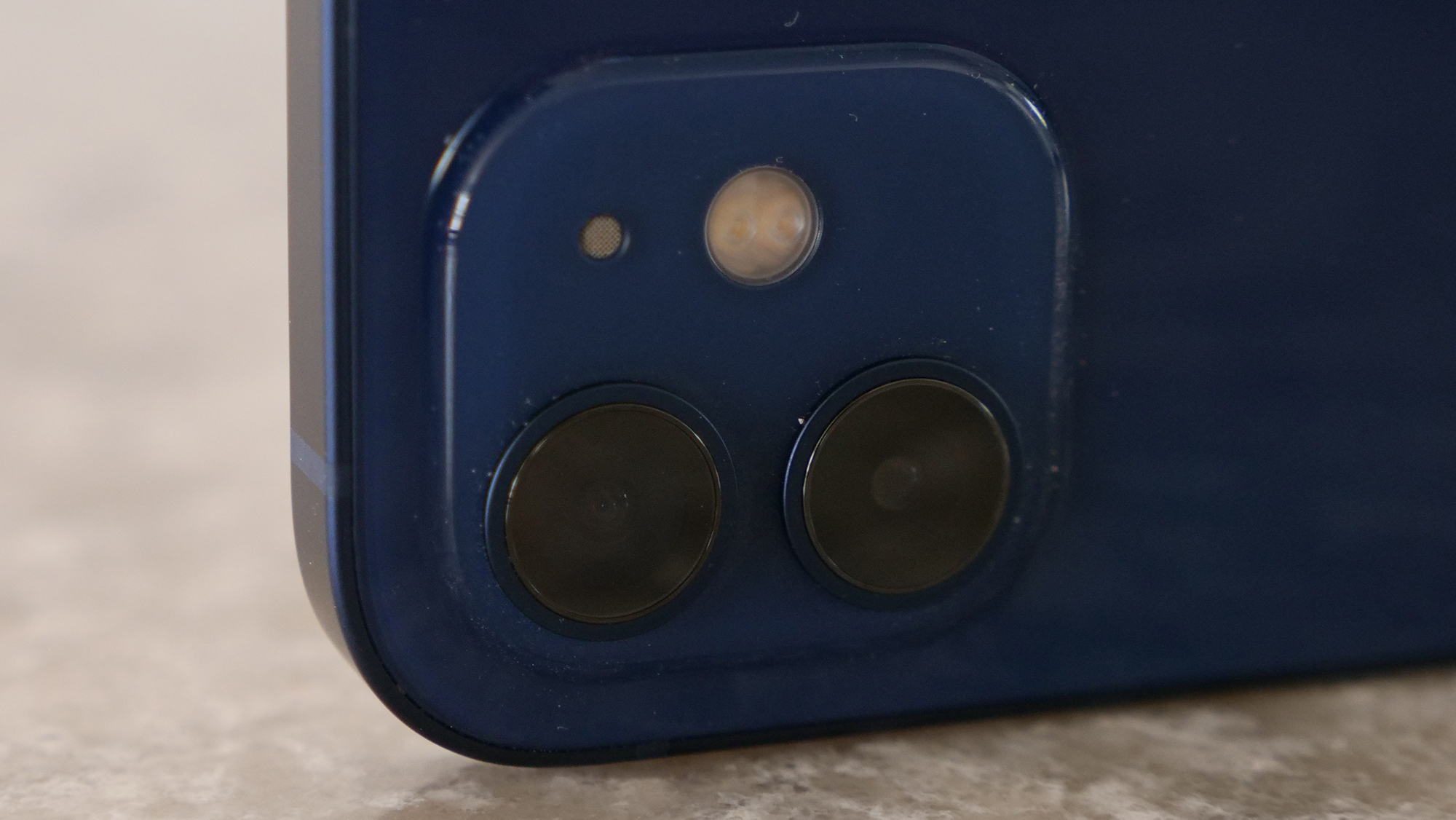
The bezels on the front of the iPhone 12 have been reduced slightly, but the notch is unchanged. There’s no question Face ID is the most reliable smartphone facial recognition, but I still find the prominent notch off-putting. Here’s hoping under-display cameras arrive soon and save us from our notched and hole-punched screens.
Looking around the aluminum frame of the iPhone 12, you have the volume up and down on the left with the silent toggle and the multi-function button used to trigger sleep/wake as well as Siri. Finally, on the bottom of the iPhone 12 is the Lightning port; yes, hope for USB Type-C ever coming to the iPhone is dwindling.
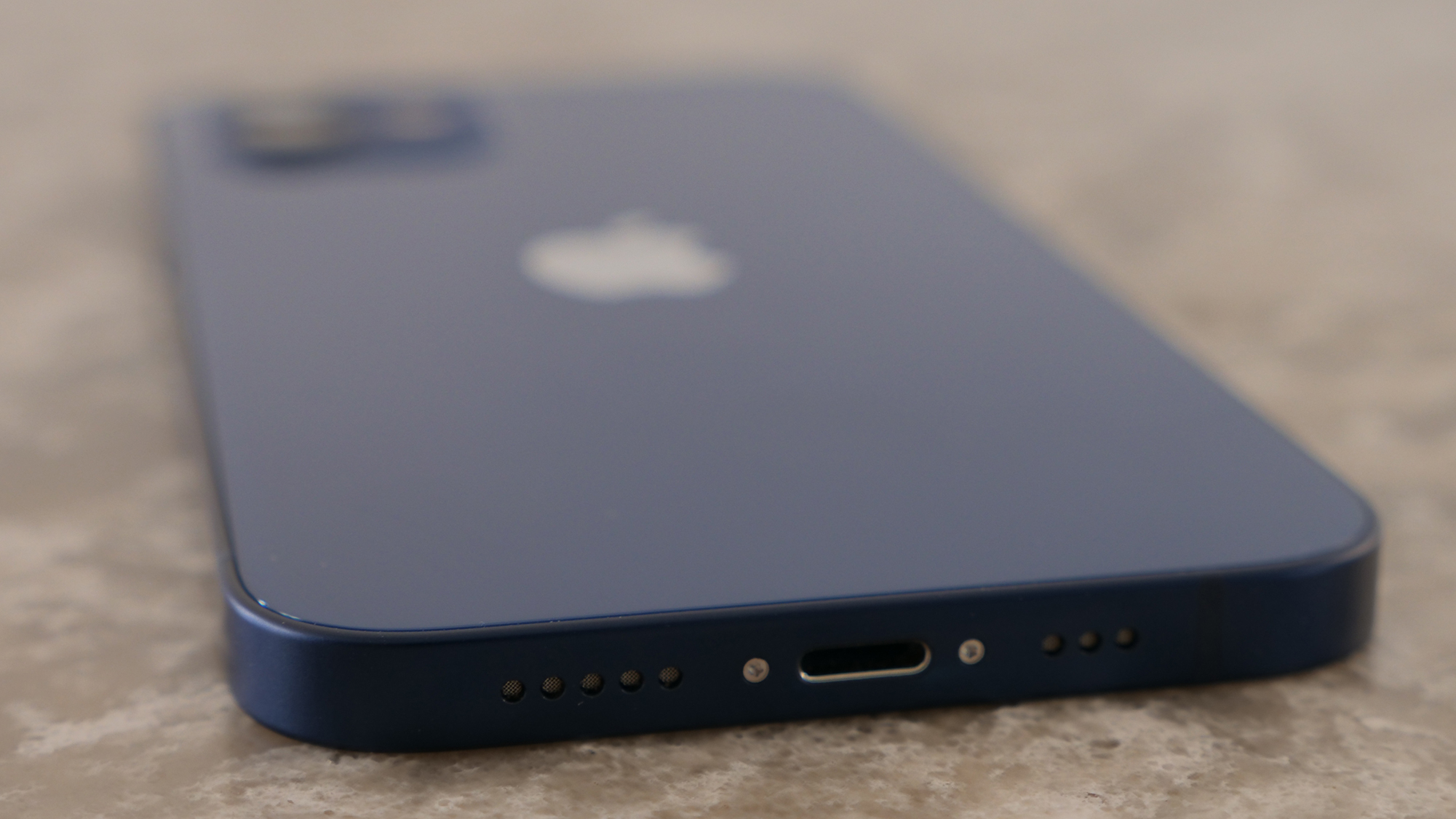
The iPhone 12 measures 5.8 x 2.8 x 0.29 inches and weighs 6.7 ounces. That is almost identical to the Pixel 5 (5.7 x 2.8 x 0.3 inches), and considerably smaller than the Samsung Galaxy S20 FE (6.3 x 2.9 x 0.3 inches) or the OnePlus 8T (6.3 x 2.9 x 0.3 inches).
Most of the talk around the iPhone’s design in recent years has centered on the notch and the removal of the headphone jack. The iPhone 12 should put an end to the bickering. While it may be a throwback, the iPhone 12 is a well-executed redesign that reasserts Apple as a design leader in the mobile world.
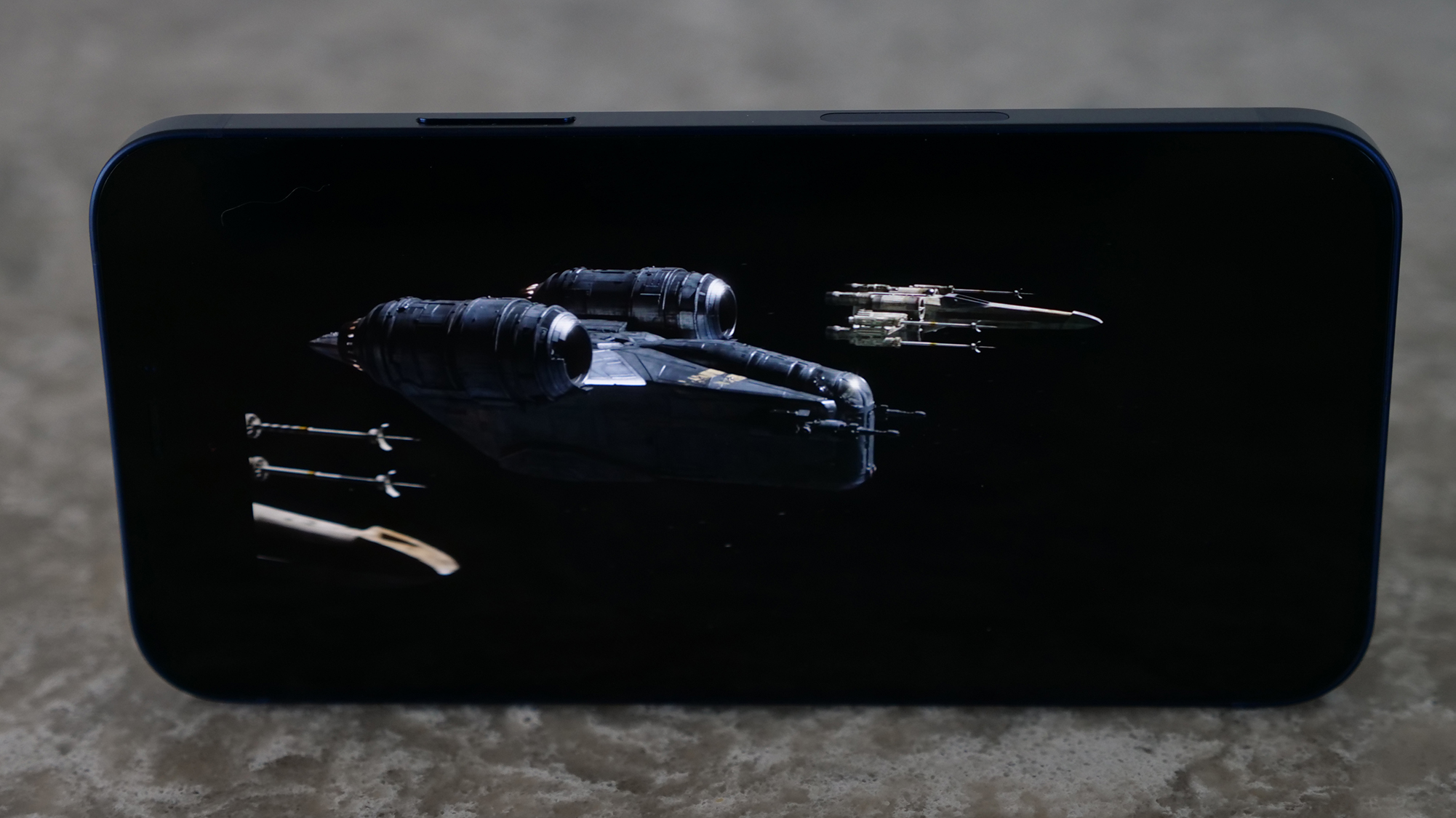
iPhone 12 display
The iPhone 12’s 6.1-inch Super Retina XDR OLED screen is one of the most significant hardware upgrades going from the iPhone 11. OLED allows for significant battery life savings compared to LCD and also offers you greater contrast and deeper black levels. Those benefits are accompanied by a dramatic resolution boost, from 1792 x 828-pixels up to 2532 x 1080-pixels.
Viewed in a vacuum, it’s an excellent display and, if you are coming from any previous iPhone, this will be a solid step up. Where it falters slightly is in comparison to some of its Android competitors.
Displays with 120Hz refresh rates, or at least 90Hz, have become commonplace over the last year on Android flagships. Apple knows this is a superior experience as it highlights ProMotion (120Hz) regularly on the iPad Pro. However ( mild spoiler for the battery life section), Apple clearly didn’t have the battery life to spare for 120Hz in these phones but, while it’s nice to have, I wouldn’t call it crucial yet.
The other piece is more of a difference in philosophy on color and vibrancy. Apple deliberately targets a more “natural” look with its displays, while Android manufacturers default to a more vivid, saturated and contrasty look. The difference is that on Android, you can opt to switch to natural if you want that experience, while on iOS, you get no such option.
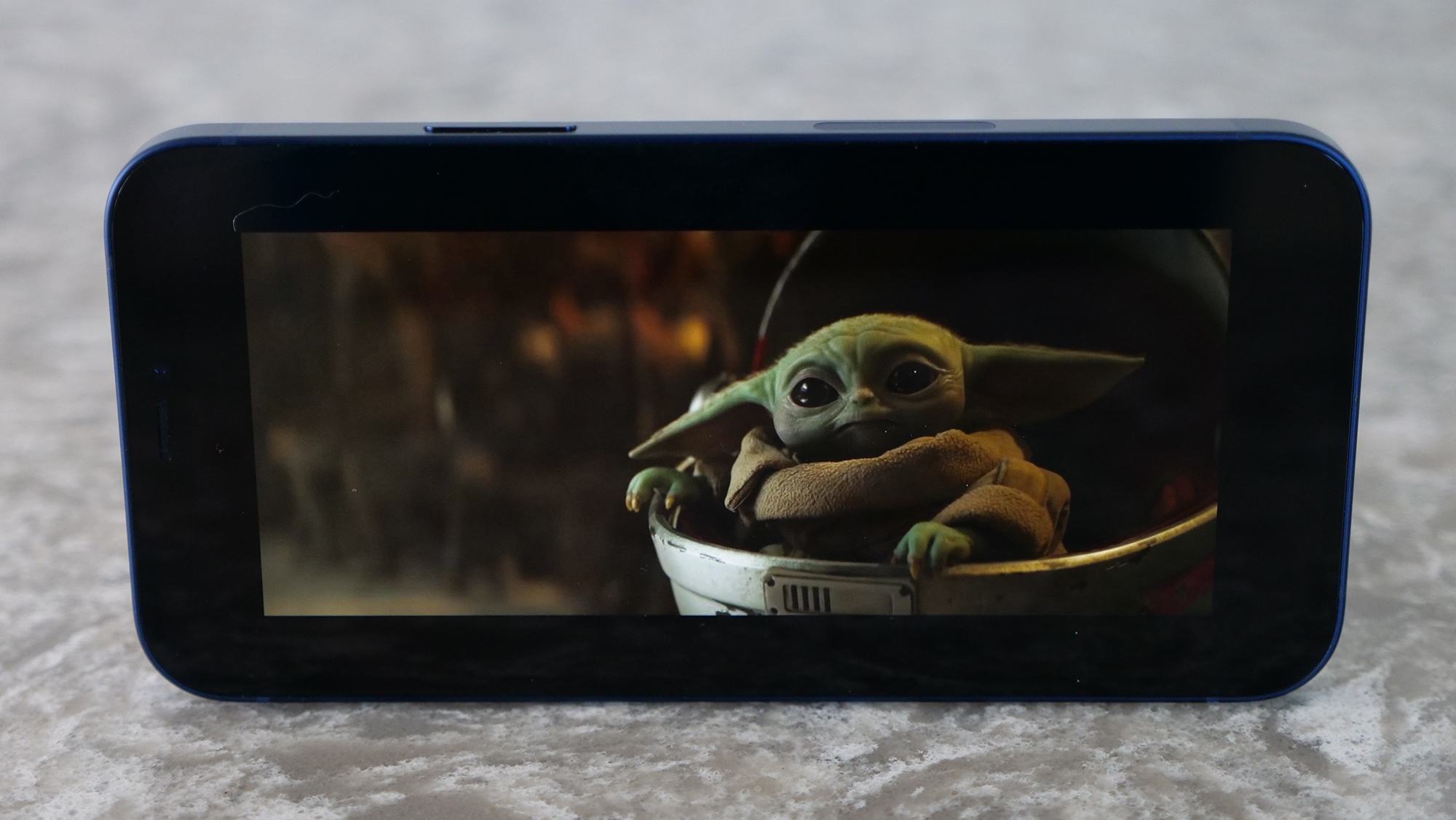
With that said, those iPhone 12 display limitations aren't apparent when viewing content. I watched the trailer for The Mandalorian Season 2 and details are crisp thanks to the improved resolution. I saw every wispy hair on Baby Yoda’s (fine, The Child’s) head. The display adapts well to the varied lighting across the disparate environments depicted in the show, including the inky black of space that comes through beautifully on the new OLED display.
Our lab tests reflect the difference between the iPhone 12 and its competitors; the iPhone 12 managed to reproduce 81.1% of the DCI-P3 color space. Its Android competitors come in well beyond that in their default settings: the Galaxy S20 FE (133.3%) leads while the Pixel 5 (128.8%) and the OnePlus 8T (120.2%) aren’t far behind it.
The results of the Delta-E color accuracy test (lower is better) were roughly even across its competition, with the iPhone 12 achieving a 0.29, matching the OnePlus 8T (0.29), but slightly ahead of both the Pixel 5 (0.3) and Galaxy S20 FE (0.3). Notably, this is a step down for the iPhone 12 versus the iPhone 11, which produced an impressive 0.22 on this test last year.
The iPhone 12 achieved a reasonable brightness at 570 nits, but it is well below Apple’s stated 625 nits and more than 100 nits dimmer than competitors. The Galaxy S20 FE was the brightest of these phones, at 679 nits with Adaptive Brightness on, and both the Pixel 5 and OnePlus 8T were right behind at 678 nits. The iPhone is still sufficiently bright to view outdoors without issue, so this is not a concern.
iPhone 12 audio
Dolby Atmos support was introduced on the iPhone 11 and is present again on the iPhone 12.
I listened to Post Malone’s “Circles” and the iPhone 12’s bottom-firing stereo speakers can get impressively loud without any distortion, easily filling my medium-sized testing room. The vocals remained crisp while the admittedly simple beat was assertive without being overpowering. While the iPhone 12 speakers hold up well enough if you are playing something for friends or family, listening privately is better with wireless headphones, particularly with the spatial audio support on AirPods Pro with the iPhone 12.
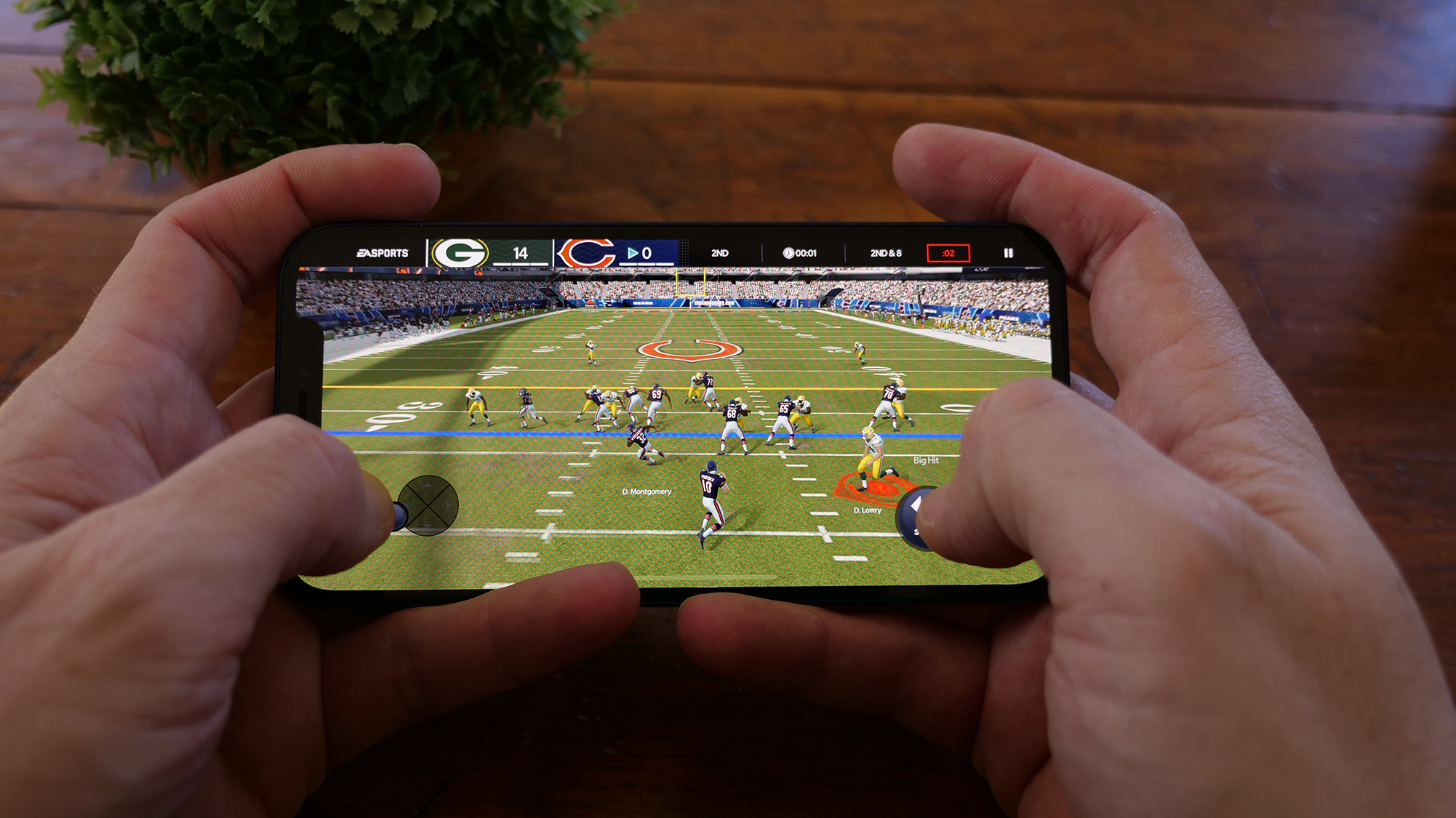
iPhone 12 performance
The iPhone 12 is almost the most powerful smartphone on the planet thanks to the A14 Bionic chip. If it weren’t for that pesky iPhone 12 Pro and iPhone 12 Pro Max, it would have the top spot. Its pricier siblings get 6GB of RAM to the iPhone 12’s 4GB, and that’s enough to give them an edge in some areas. But rest assured, the iPhone 12 leaves every other smartphone in the dust.
There’s nothing you can throw at the iPhone 12 to slow it down. I loaded up two dozen Google Chrome tabs, a handful of demanding games, all while having a Netflix show playing in picture-in-picture and it didn’t drop a frame. Regardless of what you are looking to do with your smartphone, be it gaming, productivity, video production, the iPhone 12 is going to handle it for years to come.
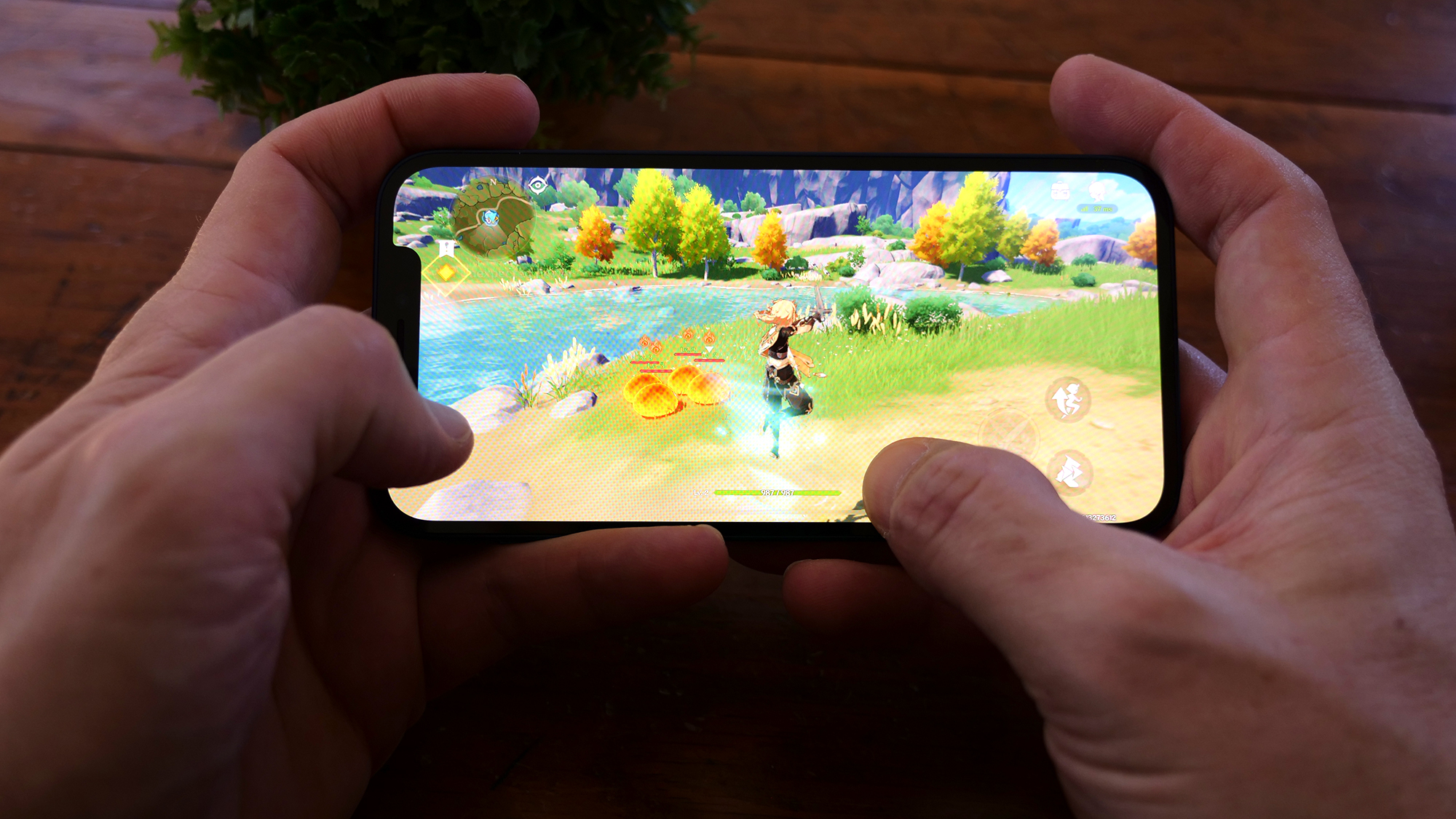
Turning to our benchmarks for a more quantitative breakdown of its performance, the iPhone 12 is way out ahead with a Geekbench 5 multi-core score of 3,859 (it actually beat the iPhone 12 Pro, 2,928, on this one). Among its competitors, the OnePlus 8T (3,203) came the closest to the challenge. Samsung’s Galaxy S20 FE (2,928) was next up and the Pixel 5 (1,617) waved at everyone from outside of the stadium as it didn’t really come to play.
GFXBench 5.0 specifically looks at graphics performance and again, the iPhone 12 shined with 2,168 frames (34 frames per second) on the Aztek Ruins High Tier Off-Screen. The competition finished in the same order with the OnePlus 8T (1,375, 21 fps), then the Galaxy S20 FE (1,325, 21 fps) and finally, the Pixel 5 (438, 7fps).
In our Adobe Premiere Rush video editing test, the iPhone 12 was finished transcoding our 4K video to 1080p in a blistering 26 seconds. The Galaxy S20 FE (1:24) was closest this time, with the OnePlus 8T (1:38) just slightly behind and the Pixel 5 (2:25) strolling across the finish line almost two full minutes after the iPhone 12.
The iPhone 12 offers the most comprehensive 5G support of any smartphone on the market at the moment, so regardless of your carrier, you will have access to the fastest speeds on offer. While I do have T-Mobile’s 5G in my area, it isn’t the mind-bending speeds of some of the 5G tests, but it does dramatically improve the coverage area for me at still solid speeds. While I’m not biting on the “5G just got real” tagline Verizon so happily spouted on stage at the iPhone 12 launch, it is more real than it has ever been and the iPhone 12 is future-proofed for it.
iPhone 12 battery life and charging
While it has never gone for the massive batteries found in some Android devices, the iPhone, in recent years, has been one of the most reliable when it came to at least getting you through a day of use. With some caveats, that is true again with the iPhone 12.
5G in its current state is a battery devouring monster. This is true on any device and a reason why we’ve seen so many Android flagships with 4,500 mAh batteries and beyond this year. Apple’s A14 Bionic and iOS itself are wizards of energy efficiency and allow the iPhone to get by with a much smaller 2,851 mAh cell.
So with that in mind, it is no shock that the iPhone 12 put up a much worse result than in previous years, enduring for 8 hours and 25 minutes of continuous web surfing at 150 nits of brightness on AT&T’s 5G network. However, before you panic, there’s an easy fix for this: turn off 5G as we showed you here, and that result jumped to 10 hours and 23 minutes using AT&T’s LTE network. By comparison, the OnePlus 8T (10:50) outlasted both iPhone 12 results, while the Pixel 5 (9:53) and Galaxy S20 FE (8:58) bested its 5G result.

As I am working from home, it isn’t surprising that my personal findings don’t really line up. My personal usage during testing included roughly an hour of Netflix and/or YouTube streaming, three to four hours of YouTube Music streaming, capturing photos and video, 30 minutes of gaming and an hour of Slack, Twitter and general web usage. Only 30 minutes to an hour of this happened away from my home on a daily basis, so the 5G battery consumption didn’t have a chance to get me. Taking the iPhone 12 off its charger at around 8:00 a.m., I would typically have around 15% remaining when I went to set it down at around 10:30 p.m.
Now, on to the charging section, and there are definite highs and lows here. Apple removed the charger from the iPhone 12 box this year; the company attributes this to an environmental effort as it obviously allows for considerably smaller packaging and eliminates the need to produce chargers that often go unused as iPhone owners already have one. It is certainly a worthy cause, and I suspect some other manufacturers will follow suit, but I have a couple of problems with how Apple has gone about it.
The first is that you get a USB Type-C-to-Lightning cable in the box. While iPhone users likely have a drawer full of USB Type-A chargers, they have little reason to have USB Type-C chargers around, after all, Apple only recently started using the new standard. The second is that Apple should have taken an approach similar to the headphone adapter. It's fine to have the courage to remove the charger, but give users a grace period to adjust by either forewarning a year in advance or offering a voucher for a USB Type-C charger that they can redeem if they wish.
On to more fun things, MagSafe is Apple’s new wireless charging method for the iPhone 12 and it thankfully augments rather than breaks Qi charging. The MagSafe charging pad, which resembles a giant Apple Watch charger, attaches to the iPhone 12 with magnets embedded in the smartphone. While not blazingly fast, it charged the iPhone 12 to 12% in 15 minutes and 29% in 30 minutes. It is quite handy to not worry about placing your phone properly on the wireless charger. If you are thinking this is the fourth horseman of the Apocalypse for the only port on the iPhone, you could be right; it wouldn’t be shocking for this to be the only solution in the not-so-distant future. For now, it’s an extra $39 to enjoy this glimpse of the future.

If you do want to charge your iPhone 12 quickly and make use of that Lightning port while it still has it, the new 20-watt USB Type-C charger from Apple is $20 and in our testing, took the iPhone 12 up to 57% in just 30 minutes.
iPhone 12 cameras
The iPhone 12, similar to the Pixel line, doesn’t necessarily blow you away with its camera specs, but it does an excellent job regardless. This is, in part, due to Apple’s greater focus on computational photography, something the A14 Bionic was specifically designed to augment.
Its two rear cameras feature 12MP sensors; an astounding f/1.6 primary wide-angle lens and an f/2.4 ultra-wide lens. The front-facing TrueDepth camera matches them at 12MP with an f/2.2 aperture.
Wide-angle camera
Apple’s standard wide-angle lens does stand out with its incredibly fast aperture; it allows you to capture images in dim lighting conditions without resorting to Night mode, which is impressive despite some limitations. Here are a few samples of the same setup in daylight and then at night both with and without Night mode to give you an idea of what’s possible.

Night Mode Test - Daylight

Night Mode Test - Night Mode off

Night Mode Test - Night Mode on
For more traditional daylight photography, the results from the wide-angle lens offer excellent detail and high dynamic range. In this image, the iPhone 12 did an excellent job delivering a range of color even as fall arrives to start washing things out a bit. The individual leaves clinging to the tree at the center are well-differentiated even on a close zoom.

And on the subject of zoom, while the iPhone 12 doesn’t get that handy telephoto of the Pro models, it does give you a 0.5x up to 5x range with digital zoom. Here’s a look at what that full range looks like. Ultra-wide and wide are both excellent, but the digital zoom falls apart pretty quickly to me. At 3x, it’s still usable (at least for sharing online) and at 5x it gets quite muddled.

iPhone 12 Ultra-Wide - 0.5x

iPhone 12 Wide-Angle - 1x

iPhone 12 Wide-Angle - 3x

iPhone 12 Wide-Angle - 5x
Ultra-wide camera
While I have a preference for telephoto lenses, I can’t argue with some of the results you can get with the ultra-wide if you like capturing landscapes or need to grab a group photo indoors, which in normal times would feel more relevant. I really liked how it handled this dusk photo over a small pond, retaining the details in the ripples on the pond while capturing some color from the sunset.

Apple made a point of its ultra-wide cameras both on the front and the back, using computational photography to eliminate the distortion at the edges that are common with these lenses. You can see the results of that here with the elements at the edge all retaining their proportions quite well.

Front-facing camera
Now you get to enjoy the benefits of the notch as the TrueDepth camera on the iPhone 12 can produce some excellent bokeh on your selfies. It does this by calculating your relative position to the phone, and produces much more realistic results, for better and worse, than what you see from Samsung without massively over smoothing.
Portrait mode
I had to pull this section out separately as the multitude of lighting options available in Portrait mode on the iPhone 12 is quite impressive. Here’s a sampling of what some of them look like. The results, particularly from something like Studio lighting, are simply amazing, and don’t always go by what you are seeing on camera. I say that because post-processing is a big part of it so the photo isn't finalized until after you snap the shot.

Portrait Mode - Stage Light Mono

Portrait Mode - High-Key Light Mono

Portrait Mode - Contour Light
Video
While Samsung can boast about 8K capture, there’s really no arguing with the iPhone 12 remaining the best video camera in the smartphone world. The 4K, 60fps capture is going to be plenty for any practical use case today and the quality of the video is simply unmatched. The stabilization, in particular, blew me away as I captured some video while riding on a gravel trail. The phone holds remarkably steady despite the jostling I couldn't prevent from happening.
Support for Dolby Vision playback and capture is a great marketing point. Currently, the iPhone 12 and 12 Pro models are the only devices that can do both, but as a word of warning, if you only share quick videos, online support for Dolby Vision isn’t available in all apps yet so it can be an issue. Support will eventually come and professionals using these tools have uses for them, but in terms of quick and easy online sharing, you may want to turn HDR off.
Some of the handy extras include slow-mo videos at up to 240fps at 1080p for capturing every last detail of some quick action and time-lapse mode for capturing less rapid action.
iPhone 12 software and warranty
The iPhone 12 runs the current iOS 14.1 build. One of the great strengths of the iPhone ecosystem is that you have day-one access to the current update and support for around five years.
iOS 14 was released back in September and it brought an interesting mix of new features that allow you to customize your iPhone. This includes things like customizable widgets, a new App Library that gives you vastly superior organization options for your apps, and some handy extras like picture-in-picture, which was shockingly still missing. I’m not sure if I would call it a feature-packed update to iOS, but much like the iPhone 12 itself, iOS14 is a nice upgrade.
The iPhone 12 comes with a one-year limited warranty. Check out our Best and Worst Brands and Tech Support Showdown reports to find out how Apple fared this year.

Bottom line
The iPhone 11 was an absolute slam dunk recommendation for the average user who was willing to spend more than $500 on a smartphone but didn’t want to crest that $1,000 mark. Both the existence of the iPhone 12 mini and a few small setbacks make it less easy to recommend the iPhone 12 this year, so I’m going to say it went from a dunk to a layup.
The combination of Apple’s unmatched software support, the gorgeous (and durable) new design, and the future-proofing of the A14 Bionic, 5G and Wi-Fi 6, make this a phone that will easily last users 3 to 5 years while still receiving the latest and greatest OS updates from Apple. The only threat to long-term use could be the battery, but remember, it costs only $69 to get a replacement, which is a small price if 2 to 3 years of hard use wears it down.
And while the iPhone 12 camera isn’t best-in-class (Samsung offers more versatility below this price point with the triple-camera on the Galaxy S20 FE and the Pixel 5 images come out ahead to my eye), it produces objectively excellent photos and the video quality is impeccable. It's worth noting as well that image quality will only improve as Apple continues to refine its computational photography.
The $700 to $800 price range is stacked this year and, while I wish Apple had come in a bit lower on price, the iPhone 12 is still the obvious choice as the best smartphone for most people.
Sean Riley has been covering tech professionally for over a decade now. Most of that time was as a freelancer covering varied topics including phones, wearables, tablets, smart home devices, laptops, AR, VR, mobile payments, fintech, and more. Sean is the resident mobile expert at Laptop Mag, specializing in phones and wearables, you'll find plenty of news, reviews, how-to, and opinion pieces on these subjects from him here. But Laptop Mag has also proven a perfect fit for that broad range of interests with reviews and news on the latest laptops, VR games, and computer accessories along with coverage on everything from NFTs to cybersecurity and more.


